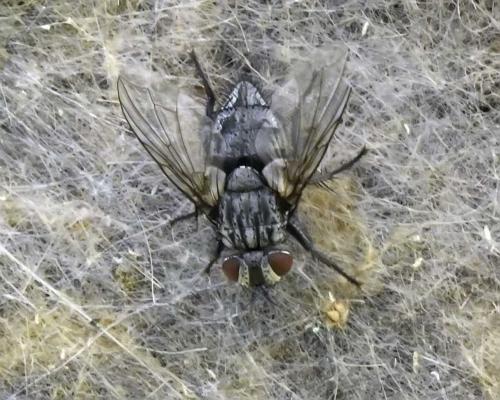Diptera.info :: Identification queries :: Diptera (adults)
|
Carcelia iliaca ? -> Phryxe semicaudata
|
|
| evdb |
Posted on 09-06-2022 08:13
|
|
Member Location: France (Loiret) Posts: 1357 Joined: 05.12.11 |
Hi, Center of France (Loiret) on 8th june 2022, in a nest of Thaumatopoea processionea. Single shot. Somebody to confirm Carcelia iliaca ? Thanks for help. 
Edited by evdb on 22-11-2022 15:44 Eugene |
| eklans |
Posted on 09-06-2022 09:03
|
|
Member Location: Franconia, Germany Posts: 4380 Joined: 11.11.18 |
Hello Eugene, it's not a Carcelia: Scutellum & tibiae are black.
Greetings, Eric |
|
|
|
| Zeegers |
Posted on 09-06-2022 16:05
|
|
Member Location: Soest, NL Posts: 19242 Joined: 21.07.04 |
Generally very valid arguments, but iliaca can be very dark. Given habitat and Thaumetopoea, this still is a likely C. iliaca to me. Theo |
|
|
|
| eklans |
Posted on 09-06-2022 16:42
|
|
Member Location: Franconia, Germany Posts: 4380 Joined: 11.11.18 |
Hi Theo, habitat and Thaumetopoea doesn't necessarily mean C. iliaca. Pales, Winthemia, Phorocera, Zenillia are out, but Exorista and Phryxe parasitize Thaumetopoea, too. And this one looks so completely differant to my iliacas: eklans attached the following image:  [176.56Kb] Greetings, Eric |
|
|
|
| evdb |
Posted on 09-06-2022 22:13
|
|
Member Location: France (Loiret) Posts: 1357 Joined: 05.12.11 |
Correct, not C. iliaca because there are discal bristles on tergits but I don't see where to go.
Eugene |
| eklans |
Posted on 10-06-2022 09:08
|
|
Member Location: Franconia, Germany Posts: 4380 Joined: 11.11.18 |
Hello Eugéne, I've checked the flies, that the T&H key associates with the OPM and could exclude these: Carcelia iliaca Pales processionae Phorocera grandis Winthemia venusta Zenillia libatrix Remain: Exorista segregata Phryxe semicaudata (with my limited knowledge: possible) Greetings, Eric |
|
|
|
| evdb |
Posted on 10-06-2022 15:15
|
|
Member Location: France (Loiret) Posts: 1357 Joined: 05.12.11 |
Thanks for the job ! Phryxe should match, there are 4 dc post. It may be P. caudata or P. semicaudata and caudata seems to be mediterranean. Greetings. Eugene |
| eklans |
Posted on 12-06-2022 17:11
|
|
Member Location: Franconia, Germany Posts: 4380 Joined: 11.11.18 |
Hello Eugéne, besides the southern occurence of caudata we can see one feature to separate caudata from semicaudata on your photo: the pruinosity of the tergites: P. caudata should have black posterior margins P. semicaudata is entirely covered. Your fly might be Phryxe semicaudata. Greetings, Eric |
|
|
|
| evdb |
Posted on 12-06-2022 23:00
|
|
Member Location: France (Loiret) Posts: 1357 Joined: 05.12.11 |
Thanks for confirmation
Eugene |
| Jump to Forum: |













